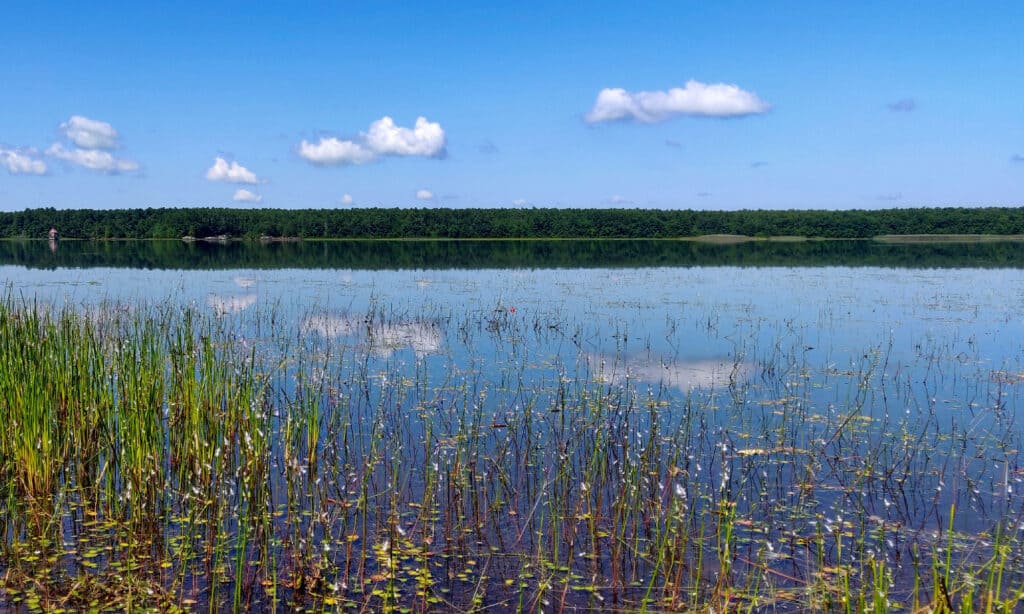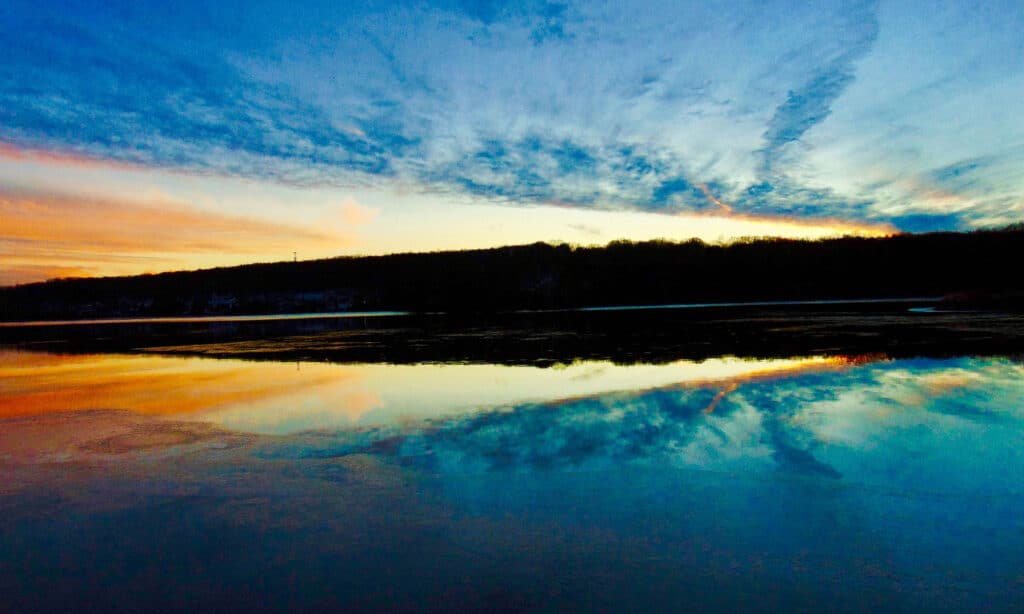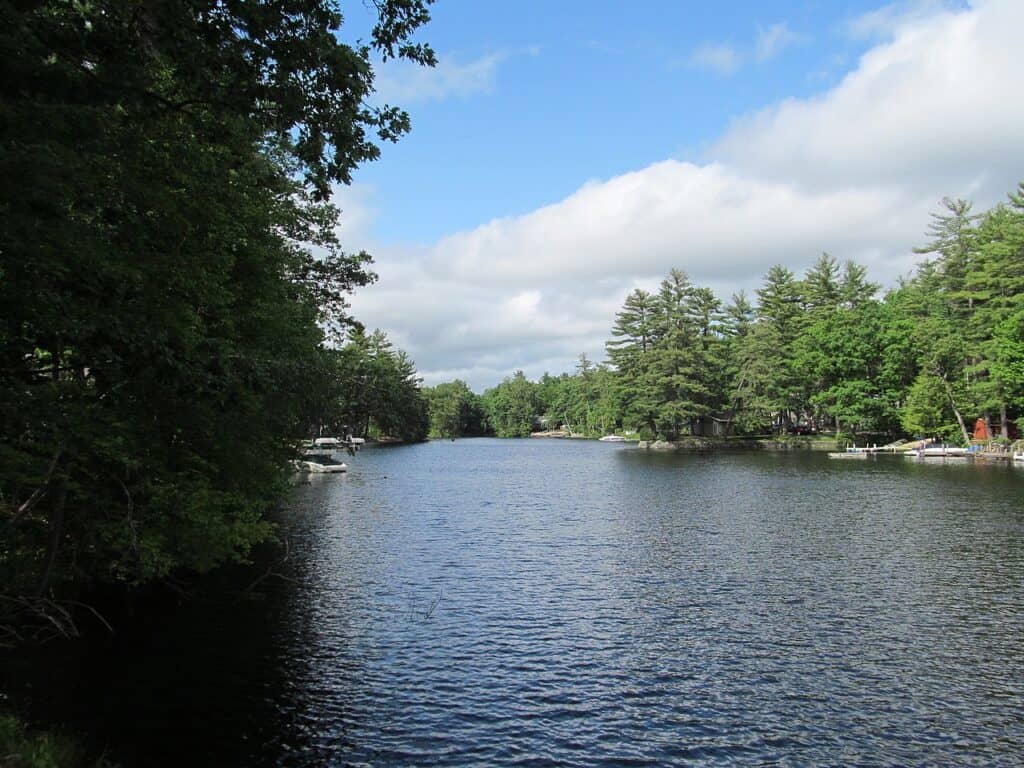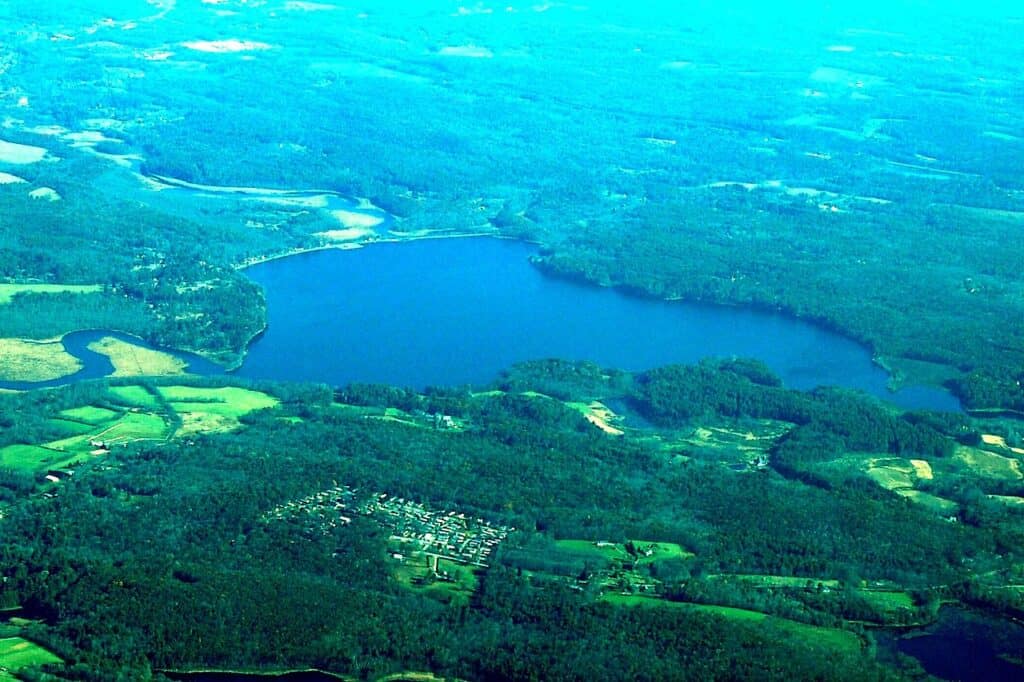Massachusetts is home to many wonderful lakes, reservoirs, and ponds. The state’s bodies of water vary in size, history, depth, and purpose greatly. From the massive Quabbin Reservoir to the quaint Great Herring Pond all of the state’s lakes offer something different.
Horseback riding near Assawompset Pond is a prime destination. Birdwatchers can set their sights on Lake Monomonac for a wealth of opportunities to view many types of birds. Who could forget Lake Chargoggagoggmanchauggagoggchaubunagungamaugg with its extremely unique and unforgettable name?
Great Herring Pond is an important spawning location for herring and Lake Quinsigamond is a historically notable rowing lake. Quaboag Pond is great for paddling and offers a wide variety of fish species. The diversity of the lakes in Massachusetts is unquestionable, the history is fascinating and of course, there is also great fishing!
Let’s examine 10 of the best lakes in Massachusetts!
1. Wachusett Reservoir

Wachusett Reservoir is the second largest lake in Massachusetts located in the central part of the state near the historic city of Worcester.
©iStock.com/carpere
| Attribute | Value |
|---|---|
| Surface Area | 4,057 Acres |
| Max Depth | 120 Feet |
| Camping/Overnight Available | No |
| Boating/Docks Available | No |
| Swimming Permitted | No |
| Fishing Permitted | Yes |
| Best For | Water Supply for Massachusetts, Fishing, Lake Trout, Record Sized Fish, Second Largest Lake in Massachusetts |
In 1905 the small towns of Boylston, West Boylston, Clinton, and Sterling Massachusetts were flooded to form the Wachusett Reservoir. Upon its creation, Wachusett Reservoir was the largest public water supply in the world and the largest body of water in the state, respectfully. Today the reservoir serves as the primary water supply for the city of Boston and provides excellent fishing opportunities.
Fishing is the main attraction at Wachusett Reservoir with swimming and boating prohibited. A slew of other tight, controversial restrictions are in place for the reservoir and surrounding area to ensure the highest possible water purity. Wachusett Reservoir is known to produce record-size brown trout, land-locked salmon, smallmouth bass, and white perch.
Wachusett Reservoir is one of the only places in Massachusetts where lake trout are present. Other fish species common to the reservoir include black crappie, bluegill, brown bullhead, chain pickerel, and largemouth bass. Anglers can also explore nearby Muddy River and the Hockomock Swamp Wildlife Management Area for even more excellent fishing opportunities!
2. Assawompset Pond

Assawompset Pond is located in southeastern Massachusetts and is the largest natural body of water in the state.
©iStock.com/raularosa
| Attribute | Value |
|---|---|
| Surface Area | 1,721 Acres |
| Max Depth | 15 Feet |
| Camping/Overnight Available | No |
| Boating/Docks Available | No |
| Swimming Permitted | No |
| Fishing Permitted | Yes |
| Best For | Fishing, Hunting, Horseback Riding, Photography, 1675 Murder Of John Sassamon, Mass Audubon Society Important Bird Area |
Assawompset Pond is located in southeastern Massachusetts. The pond is the largest natural body of water in the state. It’s historically notable for the death and subsequent discovery of the body of John Sassamon.
The pond is most utilized for fishing, hunting, and birdwatching; boating, swimming, and camping are prohibited. The most common fish species at Assawompset Pond include largemouth bass, chain pickerel, and smallmouth bass. Other fish taken home by anglers include crappie, catfish, pickerel, bluegill, and panfish.
Birdwatching is extremely productive and popular at Assawompset Pond. It has some of the highest numbers of waterfowl in Massachusetts and a range of other species. Common birds known to frequent the area include Canadian geese, bufflehead, common goldeneye, common merganser, herring gull, red-throated loon, downy woodpecker, American crow, and the red-winged blackbird.
3. Lake Chaubunagungamaug

Lake Chaubunagungamaug also known as Webster Lake is the third largest lake in Massachusetts and is known for its unique and long name.
©iStock.com/DonnaLee-B
| Attribute | Value |
|---|---|
| Surface Area | 1,442 Acres |
| Max Depth | 49 Feet |
| Camping/Overnight Available | Yes |
| Boating/Docks Available | Yes |
| Swimming Permitted | Yes |
| Fishing Permitted | Yes |
| Best For | Third Largest Lake in Massachusetts, Extremely Diverse Fishery, Longest Lake Name in the World |
Webster Lake, also known as Lake Chargoggagoggmanchauggagoggchaubunagungamaugg and Chaubunagungamaug, is known for having the longest name of any geographic location in the USA. The unique name is Loup, an Algonquian language and translates to “Fishing Place at the Boundaries, Neutral Meeting Grounds.” Today the lake is primarily known as Webster Lake however many believe the longest version to be the most accurate.
The lake is seated in southern Massachusetts, along the Connecticut border. Webster Lake has a seventeen-mile shoreline, and it’s the third-largest body of water in the state. The lake is home to eight islands, some having houses, cottages, roads, and vibrant small communities.
In addition to being known for its name, the lake also has a wide variety of fish. The common fish species reported by anglers at Webster Lake include largemouth bass, chain pickerel, and smallmouth bass. Other types of fish at the lake include bullhead, black crappie, yellow perch, white perch, sunfish, rainbow trout, brook trout, and tiger trout.
4. Otis Reservoir

Otis Reservoir, located in southwestern Massachusetts, is a popular destination for boating, swimming, water skiing, snowmobiling, and camping.
©Dylan DeCelle/Shutterstock.com
| Attribute | Value |
|---|---|
| Surface Area | 1,085 Acres |
| Max Depth | 52 feet |
| Camping/Overnight Available | Yes |
| Boating/Docks Available | Yes |
| Swimming Permitted | Yes |
| Fishing Permitted | Yes |
| Best For | Fishing, Birdwatching, Swimming, Boating, Water Skiing, Snowmobiling, Camping |
Otis Reservoir is located in southwestern Massachusetts near the towns of Otis, Tolland, and Blandford. The reservoir was created in 1865 by flooding Rand, Little, and Messenger Ponds. At the beginning of the lifespan of the reservoir, it was important as a water supply source to aid in powering mills on the Farmington River.
Today Otis Reservoir is a popular destination for boating, swimming, water skiing, snowmobiling, and camping. Tolland State Forest runs along a quarter of the Otis Reservoir’s thirty-mile shoreline and provides a boat launch, swimming area, and camping facilities. Fishing and birdwatching are two very popular activities at Otis Reservoir.
Fish species at Otis Reservoir include bass, white perch, yellow perch, tiger muskie, catfish, and bluegill. In addition, The Massachusetts Division of Fisheries & Wildlife regularly stocks the reservoir with trout. Birdwatchers at Otis Reservoir can expect to find a wide array of birds including green-winged teal, mourning dove, herring gull, least tern, downy woodpecker, American crow, northern rough-winged swallow, and the gray catbird.
5. Lake Quinsigamond

Lake Quinsigamond is a great “lake getaway” for Worcester residents offering fishing, hiking, and competitive rowing events.
©Brett Moody/Shutterstock.com
| Attribute | Value |
|---|---|
| Surface Area | 772 Acres |
| Max Depth | 85 feet |
| Camping/Overnight Available | Yes |
| Boating/Docks Available | Yes |
| Swimming Permitted | Yes |
| Fishing Permitted | Yes |
| Best For | Lake Getaway for Worcester Residents, Fishing, HIking, Competitive Rowing Events |
Lake Quinsigamond is located in eastern Massachusetts bordering the eastern side of Worcester. The lake is a popular destination for hiking, fishing, boating, and competitive rowing events. Lake Quinsigamond is conveniently located near Worcester making it a perfect “lake getaway.”
Fish species seen at Lake Quinsigamond include chain pickerel, northern pike, tiger muskellunge, carp, yellow perch, white perch, black crappie, bullhead, tiger trout, and brook trout. Lake Quinsigamond flows into the Quinsigamond River which is another great, and lesser-known, fishing destination. Fish commonly caught at the river include chain pickerel, largemouth bass, smallmouth bass, rock bass, yellow bullhead, bluegill, and pumpkinseed.
Competitive rowing at Lake Quinsigamond dates back to 1857. Today the Quinsigamond Rowing Association regularly hosts US Rowing Masters National Championship events on the lakes waters. Lake Quinsigamond is also home to eight islands varying in size and accessibility because many are privately owned.
6. Lake Cochituate

Lake Cochituate is actually three separate bodies of water connected by navigable culverts.
©public domain – License
| Attribute | Value |
|---|---|
| Surface Area | 625 Acres |
| Max Depth | 69 feet |
| Camping/Overnight Available | Yes |
| Boating/Docks Available | Yes |
| Swimming Permitted | Yes |
| Fishing Permitted | Yes |
| Best For | Beer Brewing, Trophy-Size Pike & Muskie, Sailing, Snake Brook Trail, Cross-country skiing |
Lake Cochituate is located in central-eastern Massachusetts about twenty miles west of Boston. The lake is created by three linked ponds and it originally served as the primary water supply for Boston. Today the lake is home to Cochituate State Park and is a popular destination for camping, hiking, fishing, sailing, birdwatching, and beer brewing.
The lake is split into three separate basins that are connected by navigable culverts. The southernmost basin is the largest and deepest of the three. The northern basin is the second-largest and the middle is the smallest.
All three of the basins at Lake Cochituate offer great fishing. Fish species found through MassWildlife surveys include largemouth bass, chain pickerel, common carp, yellow perch, white perch, black crappie, brown bullhead, yellow bullhead, white sucker, American eel, swamp darter, golden shiner. Lake Cochituate is also stocked with trout and northern pike and tiger muskellunge.
7. Lake Monomonac

Lake Monomonac spans from New Hampshire into northern Massachusetts and offers great fishing, boating, sailing, water-skiing, and camping opportunities.
©John Phelan, CC BY-SA 3.0, via Wikimedia Commons – License
| Attribute | Value |
|---|---|
| Surface Area | 711 Acres |
| Max Depth | 21 feet |
| Camping/Overnight Available | Yes |
| Boating/Docks Available | Yes |
| Swimming Permitted | Yes |
| Fishing Permitted | Yes |
| Best For | Fishing, Boating, Sailing, Birdwatching |
Lake Monomonac was originally created as part of the Connecticut River watershed and was formed from a small pond in New Hampshire. The lake’s waters span from New Hampshire into northern Massachusetts near the town of Winchendon. Lake Monomonac rests four hundred and twenty-five of its acres in New Hampshire and the remaining two hundred and eighty-six acres lay in Massachusetts; both sides offer great fishing, boating, sailing, water-skiing, and camping!
Lake Monomonac is managed under New Hampshire fishing laws, and anglers can fish with a valid Massachusetts fishing license as well. Primary fish species found at the lake include largemouth bass, smallmouth bass, chain pickerel, bluegill, pumpkinseed, yellow perch, and white perch. In addition, black crappie, horned pout, and green sunfish have been observed.
Two islands, Blueberry and Paradise, rest in Lake Monomonac and are accessible by canoe or kayak for exploration. In addition to the lake, the Annett State Forest and Winchendon State Forest are both nearby or border the water. Bird species found at and around the lake include brown thrashers, catbirds, towhees, meadowlarks, Baltimore orioles, winter wrens, golden-crested kinglets, juncos, white-throated sparrows, and, black and yellow warblers.
8. Quaboag Pond

Quaboag Pond, once named Podunk Pond, is a popular summer destination for warm water fishing and padding.
©LymanSchool (Richard B. Johnson) / CC BY-SA 3.0 – License
| Attribute | Value |
|---|---|
| Surface Area | 537 Acres |
| Max Depth | 10 feet |
| Camping/Overnight Available | No |
| Boating/Docks Available | Yes |
| Swimming Permitted | Yes |
| Fishing Permitted | Yes |
| Best For | Warm Water Fishing, Paddling, Fly Fishing Nearby Quaboag River |
Once named Podunk Pond, now called Quaboag Pond, is located in south-central Massachusetts near Brookfield. The pond is considered part of the Chicopee River Watershed and it flows into the Quaboag River. Swimming, paddling, and boating are all very popular activities at Quaboag Pond during the summer months.
Nearby Lake Lashaway flows into Quaboag Pond and therefore shares the same fish species. Anglers can expect to catch large and smallmouth bass, chain pickerel, yellow perch, white perch, black crappie, bluegill, pumpkinseed, brown and yellow bullhead, golden shiner, and carp at Quaboag Pond. In addition, the Quaboag River feeds into Quaboag Pond and offers even more fishing opportunities for rainbow, brook, and brown trout.
Quaboag Pond is a mostly shallow body of water reaching only ten feet at max depth. This makes the pond a very popular summer attraction when the water warms up. Padding is a popular activity at Quaboag Pond with the connecting bodies of water offering further exploration and fun.
9. Great Herring Pond

Great Herring Pond, historically known as Lake Manomet, is located in southeastern Massachusetts near Plymouth and is home to massive turtles with football-sized heads!
©John Phelan / Creative Commons – License
| Attribute | Value |
|---|---|
| Surface Area | 424 Acres |
| Max Depth | 47 feet |
| Camping/Overnight Available | No |
| Boating/Docks Available | Yes |
| Swimming Permitted | Check Water Conditions |
| Fishing Permitted | Yes |
| Best For | Smallmouth Bass & White Perch Fishing, Massive Turtles Sightings, Remarkably Clear Water, Important Herring Spawning Spot |
Great Herring Pond is located in southeastern Massachusetts near Plymouth; it was historically known as Lake Manomet. The pond’s waters flow from Little Herring Pond and then out to the Herring River. The bottom of Great Herring Pond is primarily sand mixed with rubble and mud in the deeper and more covered areas.
The pond’s five-plus mile shoreline is moderately developed offering good smallmouth bass and white perch fishing. Many other fish species have also been recorded through MassWildlife surveys including white perch, white sucker, brown bullhead, banded killifish, largemouth bass, pumpkinseed, chain pickerel, golden shiner, tessellated darter, American eel, alewife, and blueback herring. Massive turtles measuring from four to five feet long can also be commonly observed at the pond.
The pond’s size makes it ideal for canoes, kayaks, inflatable, and other hand-carried craft and there is a gravel boat ramp suitable for small boats. Great Herring Pond is an important body of water for spawning herring. The dense population of herring is a great food source for striped bass, making the pond a “striper fishing hotspot.”
10. Quabbin Reservoir

Quabbin Reservoir is one of the largest reservoirs in North America and provides much of Massachusetts with drinking water.
©iStock.com/jon pursell
| Attribute | Value |
|---|---|
| Surface Area | 119,940 Acres |
| Max Depth | 151 feet |
| Camping/Overnight Available | No |
| Boating/Docks Available | Yes |
| Swimming Permitted | No |
| Fishing Permitted | Yes |
| Best For | One of the Largest Reservoirs in North America, Drinking Water Supply for Massachusetts, Four Lost Towns of Quabbin Reservoir, Spectacular Fall Foliage |
Quabbin Reservoir is the largest lake in the state of Massachusetts. With maximum depths of over one hundred and fifty feet, the massive reservoir can hold up to four hundred and twelve billion gallons of water. Originally created in the nineteen-thirties the reservoir was formed to supply Boston with water.
Today the lake serves as a popular destination for fishing. Please note that both swimming and camping at the Quabbin are prohibited, and that violations can lead to fines. You can obtain the most up-to-date information on the Massachusetts DCR website. Prior to forming the reservoir, there were four towns in the area where the water now rests. The residents of the towns were relocated and the areas where the towns once stood were flooded.
Primary fish species caught at Quabbin Reservoir include lake trout, brown trout, rainbow trout, brook trout, landlocked salmon, chain pickerel, largemouth bass, and smallmouth bass. Other types of fish reported at the reservoir include yellow perch, white perch, brown bullhead, yellow bullhead, bluegill, calico bass, golden shiner, and pumpkinseed. Quabbin Reservoir is one of the largest human-made drinking water reservoirs in the United States.
The photo featured at the top of this post is © iStock.com/jon pursell
Thank you for reading! Have some feedback for us? Contact the AZ Animals editorial team.






